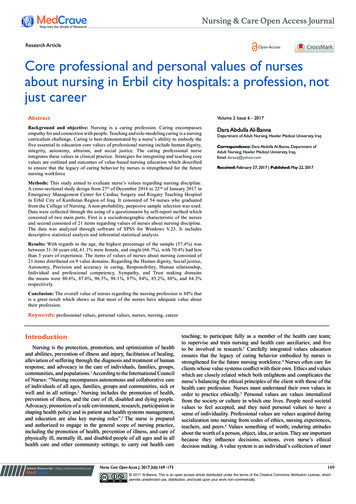
Transcription
Caring for patients with aleft ventricular assist deviceThorough knowledge of left ventricular assist devices makescaring for these patients a rewarding challenge.By Heather Martonik, MSN, RNNEARLY 6 MILLION Americanssuffer from heart failure (HF). TheAmerican Heart Association predictsthat the number of individuals diagnosed with HF will increase 46% by2030. HF can’t be cured, but it canbe managed with medications—until it reaches an advanced stage. Atthat point, a heart transplant or animplanted left ventricular assist device (LVAD) is the only long-termoption for survival.A continuous-flow pump, theLVAD directs blood from the leftventricle to the ascending aorta.(See Understanding the LVAD.)The Food and Drug Administration(FDA) first approved the LVAD forpatients waiting for heart transplants; when used for this purpose,the device is considered a bridge totransplant. While a heart transplantis optimal, demand for donor heartsfar exceeds supply. For that reason,LVADs have become increasinglypopular as a destination therapy.The HeartMate II by Thoratec isthe only FDA-approved LVAD fordestination therapy.Since 2006, more than 20,000 patients have received LVADs as destination therapy, and this number isexpected to increase. For this reason,nurses need to become more knowledgeable about—and confident in—caring for patients with these devices. This article discusses nursingcare of patients with LVADs for destination therapy, including device andmedication management, potentialcomplications, patient education, andpsychosocial support for patients,home caregivers, and nurses.20American Nurse TodayIllustration: Wikipedia, Blausen Medical Communications, Inc.Who benefits from an LVAD?Although no stringent patient-selection guidelines exist, a providerusually refers a patient for an LVADwhen advanced HF no longer re-CNE1.49 contacthoursL EARNING O BJECTIVES1. Describe the assessment of patients with a left ventricular assistdevice (LVAD).2. Discuss nursing management ofpatients with an LVAD.3. State possible complications froman LVAD.The author and planners of this CNE activity havedisclosed no relevant financial relationships withany commercial companies pertaining to thisactivity. See the last page of the article to learnhow to earn CNE credit.Expiration: 5/1/20Volume 12, Number 5sponds to inotropic drugs or surgical interventions, such as valve repair. Patient evaluation for an LVADincludes nutritional status, end-organ function, right ventricular function, and signs or symptoms of infection. Patients also should bescreened for depression and otherpsychological problems.The selection process includes determining if a home caregiver is willing and able to care for the patientaround the clock for at least 3 to 6months after surgery. Home caregivers must learn how to care for thedevice and assist patients. Caregiverresponsibilities include helping patients manage their LVAD, monitoring for infection, changing drivelinedressings, managing medications, assisting with activities of daily living,and providing transportation to andfrom medical appointments. Depending on the patient’s needs andwhether complications occur, caregiving may be needed for the rest ofthe patient’s life.Approval for an LVAD typicallyoccurs over several meetings between the patient and family and ateam consisting of a cardiologist, acardiothoracic surgeon, an LVAD (orVAD) coordinator, a social worker,and a palliative care provider. ManyVAD coordinators are RNs whohave special training in these devices. Based on the team’s recommendation, the cardiothoracic surgeon will ultimately decide if thepatient is a candidate for an LVAD.Proper assessmentCaring for the hospitalized patientAmericanNurseToday.com
with an LVAD begins with a thorough assessment of both the patient and LVAD.Monitor blood pressure and meanarterial pressure (MAP); the goal is60 mm Hg to 90 mm Hg. ElevatedMAP decreases flow and perfusion.If MAP is too high, the patient mayrequire antihypertensive drugs, suchas metoprolol, hydralazine, andisosorbide dinitrate. These drugsmay need to be adjusted until thegoal MAP is reached. Always checkwith the provider before holdingany medications due to a low MAP.Check the LVAD each time youassess the patient’s vital signs. Youwill hear the continuous hummingsound of the pump when auscultating the heart. Make sure the batterycharging station is plugged into thewall and at least two spare batteriesare in the charge station; a greenlight indicates a full charge. Additional safety checks include assessing thedriveline to ensure it’s securely inplace and confirming there’s a backup system controller in the room.The LVAD may be connected tothe power module, which isplugged into the wall; or, to allowmore mobility, the patient maywear the batteries in a holster.When the device is plugged intothe module, several numbers onthe system monitor indicate pumpflow, pump speed, pulse index,and power. (See The 4 Ps of theLVAD.) If the patient is wearing abattery holster, the numbers mustbe read from the controller.Technical care of the LVADThe LVAD requires regular care andsystem checks, including powersource changes, daily self-tests, anddriveline dressing changes. Performing these tasks in the hospitalprovides teaching opportunities forpatients and caregivers. (See Essential education for patients andcaregivers.)Switching power sourcesPatients and caregivers can learnAmericanNurseToday.comUnderstanding the LVADA left ventricular assist device (LVAD) is a continuous-flow pump that connects the leftventricle to the ascending aorta via an internal cannula. The illustration below showsthe elements of the pump.To power the LVAD, a percutaneous lead (driveline) exits the abdominal wall andconnects to a system controller and a power module that remains plugged into a walloutlet. Patients also can connect their LVAD to two lithium-ion batteries. They may wearthe batteries on a belt or a vest for increased mobility. Batteries last approximately 12to 14 hours. The system controller has approximately 15 minutes of battery life, butnever rely on it for battery power.Patients have a set of two backup batteries, a charging station, and a shower bag tokeep the controller dry while showering. Caution them not to swim or soak in a bathor hot tub.AortaHeartPercutaneouslead exitingthe bodyHeartMate IILVADPower leadImage from Abbott. All rights reserved. Used with permission.how to change between batteriesand the power module by watchingyou do it, so try to do it the sameway every time. For example, always change out the white powercables first and then the black.To change from one powersource to the other, push the connectors of the white cables togetherand turn counterclockwise to disconnect. To reconnect, align thehalf moons on the connectors, pushthem together, and turn clockwiseuntil they’re flush. Repeat the samesteps with the black cables. Think“power, patient, power” to remindyourself to disconnect and reconnect one power source at a time.Never disconnect both sets of cables at the same time; this essentiallyleaves the patient without a powersource. The system controller provides power for a limited time, butnever rely on it. Tell the patient thedevice will sound an alarm whenchanging between power sources.May 2017American Nurse Today21
Performing a daily self-testTeach the patient to perform a daily self-test to ensure the LVAD isworking properly. When the patientpresses and holds the battery button on the system controller, thescreen displays “Self Test.” If thepanel is working properly, the audio alarm will sound and controlpanel alarms will light up. Thesealarms include power and batteryalarms, a red heart (hazard) alarm,and a wrench (advisory) alarm.Changing the driveline dressingAssess the driveline site during eachpatient assessment, or more frequently if you’re concerned aboutdislodgment. Except under specialcircumstances, the driveline dressings must be changed daily or everyother day, depending on the provider’s order and how long the patient has had the LVAD. (See How tochange a driveline dressing.)Ultimately, you’re responsible forensuring the dressing change iscompleted; however, if you or theVAD coordinator have trained andobserved the patient and caregiverchanging the dressing, you can letthem do it.Medication managementPatients with LVADs are typicallyprescribed several medications, including anticoagulants, antiplateletagents, antihypertensives, antiarrhythmics, fluids, and electrolytes.Anticoagulants and antiplateletsAnticoagulants and antiplatelets (forexample, heparin, warfarin, and aspirin) help prevent pump thrombosis. However, these drugs increasehemorrhage risk.AntihypertensivesAdequate blood pressure (typically,a MAP between 60 mm Hg and 90mm Hg) helps maintain sufficientpump flow. Commonly prescribedantihypertensive drugs include: vasodilators, such as hydralazineand isosorbide dinitrate22American Nurse TodayThe 4 Ps of the LVADMonitor these key parameters on your patient’s left ventricular assist device (LVAD). Pump flow is an estimate of cardiac output based on pump speed and power.It typically ranges from 4 to 6 L/minute. Pump flow is influenced by mean arterial pressure (MAP); a higher MAP increases pump flow, and a lower MAP decreases it. Pump speed indicates the speed at which the LVAD rotors are spinning. Theusual range is 8,600 to 9,800 rpm. Pulse index (PI) is a measurement of flow through the pump and is determined by pump speed and the patient’s native heart function. PI typicallyranges from 3 to 7. Lower values reflect less native heart function and greaterreliance on the pump, while higher values reflect more native heart functionand less support by the pump. Power is the amount of wattage (W) the device needs to maintain speed andflow. The normal range is 4 to 7 W. beta blockers, such as metoprolol and carvedilol angiotensin-converting enzyme(ACE) inhibitors, such as lisinopril.Always monitor heart rate andblood pressure when giving thesemedications.Fluid and electrolyte replacementMost patients with HF are restrictedto 2 L of fluid per day. For patientswith LVADs, who depend on adequate volume and pressure tomaintain flow, you may need topush fluids to achieve the best filling pressures. For patients withlong-term HF, provide education toensure they don’t become dehydrated after receiving the device.The decision to push fluids depends on the patient’s hemodynamic status. Signs of compromised fluid status include decreased pumpflow and pulse index, as well as increased hemoglobin and hematocrit. Common indications of fluidoverload, which can lead to rightventricular failure, include weightgain, edema, and shortness ofbreath, all of which indicate increased preload.Keeping electrolytes, such aspotassium, magnesium, sodium,and calcium, within normal rangeshelps prevent arrhythmias. Checkyour patient’s basic metabolic panel, comprehensive blood count,prothrombin time, and internationalnormalized ratio (INR) daily.Volume 12, Number 5Managing complicationsCommon LVAD complications include infection, pump thrombus,hemorrhage, arrhythmias, and suction events.InfectionSeveral factors put patients withLVADs at high risk for infection—forexample, malnutrition. Potentialsources of infection include ventilators, central venous catheters, peripheral I.V. lines, and indwelling urinary catheters. Keep in mind that allhospital patients are at risk for methicillin-resistant Staphylococcus aureus infection and Clostridium difficile infection, as well as pressureinjuries, which can become infected.After surgery, driveline infectionsare common. To help prevent theseinfections, provide thorough patientand caregiver education on performing driveline dressing changes.Pump thrombusSigns and symptoms of pump thrombus include increased heart rate,shortness of breath, increased pulsepressure, and a steady increase inpump power over several days. Ifthe pump is completely occluded bya clot, the pump flow rate decreases.Notify the provider immediately ifthe patient experiences any of theseproblems. Treatment of pump thrombus involves anticoagulant or antiplatelet therapy, direct infusion of alocal thrombolytic into the LVAD, orAmericanNurseToday.com
Essential education for patientsand caregiversEducating the patient, family, and home caregivers about proper care of the leftventricular assist device (LVAD) helps everyone feel more comfortable with thedevice and can reduce complications. Encourage patients and caregivers to handle the LVAD equipment soon aftersurgery so they become comfortable with it. Teach the patient and caregiver how to change the driveline dressing andhave them perform a dressing change for you. Use the teach-back method when educating about signs and symptoms of infection and ways to reduce risks. Advise patients and caregivers to change the power source (see the photo below) the same way every time. For example, teach them to disconnect andconnect the white cables first and then the black cables. Provide education about the purpose of medications, what to do if the patientmisses a dose, and adverse reactions to report to the provider. Teach patients and caregivers to take the patient’s vital signs and explain thenormal ranges for heart rate and blood pressure. Ensure patients and caregivers know how to respond to LVAD alarms. Explain what to do if an emergency occurs. Emphasize the importance of notifying the local power company about theLVAD to ensure the home is a priority for power restoration if an outage occurs.tachycardia and atrial fibrillation, arecommon in LVAD patients. Many ofthese patients had a pacemakerplaced before surgery to treat atrialfibrillation. After LVAD placement,arrhythmias are medically managedwith antiarrhythmic agents, such asamiodarone and digoxin. For a newonset arrhythmia, assess the patientto see if he or she is stable or symptomatic, check electrolyte levels, andnotify the provider.Contact the provider and VADcoordinator immediately if the patient experiences symptomatic orsustained ventricular tachycardia(longer than 30 seconds) or ventricular fibrillation. If the patientbecomes unresponsive, call a codeblue. Avoid chest compressionsexcept as a last resort becausethey can dislodge the LVAD andcause irreparable damage. Givemedications per advanced cardiaclife support protocol. You canleave the pump running duringdefibrillation.Psychosocial supportPower source for LVADPhoto from Abbott. All rights reserved. Used with permission.pump replacement. To avoid theseproblems, monitor lab values to helpensure the patient’s INR is in thetherapeutic range, typically 2 to 3.HemorrhageLifelong anticoagulant use puts patients at risk for hemorrhage, especially stroke or GI bleeding. Signsand symptoms of GI bleeding arefrank red to black tarry stools, asignificant drop in hematocrit, decreased oxygen saturation, pallor,and dizziness. Anticoagulant therapymay need to be adjusted, and thepatient may require blood products.Suction eventA suction event occurs when pressure inside the ventricles drops tooAmericanNurseToday.comlow, causing the internal cannula toadhere to the left ventricular septum. This typically results from hypovolemia. Other causes includehigh pump speed and poor internalcannula positioning. A suctionevent isn’t life-threatening in itselfbut can lead to ventricular arrhythmias, such as ventricular tachycardia. Notify the provider immediately if you suspect a suction event.Treatment may include pushingfluids to restore ventricular pressure, treating the cause of hypovolemia (such as over-diuresis or GIloss), or surgery to restore propercannula positioning.ArrhythmiasArrhythmias, such as ventricularPatients with LVADs experiencemany physical and emotionalchanges. Although there are manyphysiological benefits (increasedenergy, reduced shortness ofbreath), patients may become depressed or even suicidal. Many patients feel socially isolated and express frustration over loss of controland dependency on family andcaregivers. Others may be afraid oftheir device.Assess patients for depression onadmission and throughout theirhospital stay. Ask how they’re managing daily life using open-endedquestions, such as: How has your life changed sincereceiving an LVAD? What are your greatest concernsafter leaving the hospital? How will you cope with theseconcerns? What are some benefits andchallenges you’ve experiencedsince receiving your LVAD?May 2017American Nurse Today23
Teach coping skills, such asjournaling, meditation, art therapy,prayer, and the importance ofreaching out to others. Patientswith LVADs can offer significantsupport to one another, so provideinformation about support groups.Caring for the home caregiverCaregiving can be burdensome.Many caregivers express fear of theLVAD, regret taking on the role, orexperience depression and anxiety.They need support, even if the patient has had an LVAD for a longtime. Provide caregivers with resources for support groups wherethey can receive encouragementand respite care.Self-care for the nurseMany nurses who are new to caring for patients with LVADs express anxiety over caring for thispatient population. Make sureyou’re up-to-date with your employer’s standard education onLVADs. Refamiliarize yourself withthe equipment and ask to shadowa nurse who’s caring for a patientwith an LVAD. Ask for help fromsomeone who’s more experienced.VAD coordinators are excellentsources of support, so find outwho’s on call and how to reachhim or her.In many cases, nurses who carefor patients with LVADs get toknow them and their families welland may experience grief if a patient becomes seriously ill or dies.If you feel you’re experiencing griefor burnout, reach out to a trustedcoworker, manager, or counselor.Spend days off doing somethingenjoyable, such as spending qualitytime with family, friends, or a pet.Treat yourself to a massage or a relaxing bath, go outside, take a yogaclass, or meditate. Most important,never forget why you became anurse.Rewarding challengeAs the population of patients with24American Nurse TodayHow to change a driveline dressingRemove the old dressing and assess the exit site for signs of infection. Ensure1 theexit site is clean and dry, with no redness or drainage.a back-and-forth motion, clean the area surrounding the exit site with2 Usingchlorhexidine, moving from the area immediately around the driveline exit siteoutward. Don’t use a circular motion, as this increases infection risk.the driveline with a new chlorhexidine swab, sweeping away from the3 Cleanexit site to prevent bacteria from traveling up the driveline.a 2" x 2" gauze pad and tuck it underneath the driveline; cover it with an4 Foldother 2" x 2" gauze pad.5Use low-adherent tape to cover the gauze pads, tearing one side just enoughto tuck under the driveline. Ensure a proper securement device is intact andplaced several inches lateral from the driveline exit site. It should provide justenough slack to the driveline so it’s not taut.advanced HF increases, nurses inall healthcare settings need to become familiar with the care of patients with LVADs, including deviceassessment and management, potential complications, and patientand caregiver education and support. Caring for the patient with anLVAD can be challenging, but it’salso immensely rewarding.Heather Martonik is a registered nurse in the coronary care unit at the Pulse Heart Institute at MultiCare Health System in Tacoma, Washington.Selected referencesBenjamin EJ, Blaha MJ, Chiuve SE, et al.Heart disease and stroke statistics—2017 update: A report from the American Heart Association. Circulation. 2017;135(10):e146-603.Brouwers C, Denollet J, Caliskan K, et al.Psychological distress in patients with a leftventricular assist device and their partners:An exploratory study. Eur J Cardiovasc Nurs.2015;14(1):53-62.Bruce CR, Delgado E, Kostick K, et al. Ventricular assist devices: A review of psychosocial risk factors and their impact on outcomes. J Card Fail. 2014;20(12):996-1003.Doty D. Ventricular assist device and destination therapy candidates from preoperativeselection through end of hospitalization. CritCare Nurs Clin North Am. 2015;27(4):551-64.Hohner E, Crow J, Moranville MP. Medication management for left ventricular assistdevice thrombosis. Am J Health Syst Pharm.2015;72(13):1104-13.Jennings DL, Jones MC, Lanfear DE. Assessmentof the heart failure pharmacotherapy of patientsVolume 12, Number 5with continuous flow left-ventricular assist devices. Int J Artif Organs. 2012;35(3):177-9.Magid M, Jones J, Allen LA, et al. The perceptions of important elements of caregivingfor a left ventricular assist device patient: Aqualitative meta-synthesis. J Cardiovasc Nurs.2016;31(3):215-25.Marcuccilli L, Casida JJ, Bakas T, Pagani FD.Family caregivers’ inside perspectives: Caringfor an adult with a left ventricular assist device as a destination therapy. Prog Transplant. 2014;24(4):332-40.Miller LW, Guglin M. Patient selection forventricular assist devices: A moving target. JAm Coll Cardiol. 2013;61(12):1209-21.Modica M, Ferratini M, Torri A, et al. Qualityof life and emotional distress early after leftventricular assist device implant: A mixedmethod study. Artif Organs. 2015;39(3):220-7.Ottenberg AL, Cook KE, Topazian RJ, et al.Choices for patients “without a choice”: Interviews with patients who received a left ventricular assist device as destination therapy. CircCardiovasc Qual Outcomes. 2014;7(3):368-73.Park SJ, Milano CA, Tatooles AJ, et al. Outcomes in advanced heart failure patients withleft ventricular assist devices for destinationtherapy. Circ Heart Fail. 2012;5(2):241-8.Rommel JJ, O'Neill TJ, Lishmanov A, et al.The role of heart failure pharmacotherapyafter left ventricular assist device support.Heart Fail Clin. 2014;10(4):653-60.Thoratec Corporation. HeartMate II LVASclinical operation & patient management.2011. www.thoratec.com/ assets/downloadtracker/HM II Clin Op & Pt Mgt 104185BENGLISH.pdfThoratec Corporation. Proven alternative foradvanced heart failure. eToday.com
POST-TEST Caring for patients with a left ventricular assist deviceEarn contact hour credit online at tion/CNECNE: 1.49 contact hoursProvider accreditationThe American Nurses Association’s Center for Continuing Education and Professional Development is accredited as aprovider of continuing nursing education by the AmericanNurses Credentialing Center’s Commission on Accreditation.ANCC Provider Number 0023.Contact hours: 1.49ANA’s Center for Continuing Education and Professional Development is approved by the California Board of Registered Nursing, Provider Number CEP6178 for 1.79 contact hours.Please mark the correct answer online.1. George Davidson,* a 60-year-old man withsevere heart failure, is on the heart transplantlist. As a bridge, he receives a left ventricularassist device (LVAD). You are Mr. Davidson’snurse today. You know you need to monitor hismean arterial pressure, which should be kept ata. 20 mm Hg to 40 mm Hg.b. 30 mm Hg to 60 mm Hg.c. 60 mm Hg to 90 mm Hg.d. 90 mm Hg to 100 mm Hg.2. Which of the following would alert you to apossible safety issue with Mr. Davidson’s LVAD?a. An additional system controller in the roomb. Continuous humming sound onauscultationc. Two batteries in the charging stationd. Yellow light on the battery charging station3. When explaining the LVAD to Mr. Davidson,you tell him that ita. connects the right ventricle to theascending aorta.b. connects the left ventricle to the ascendingaorta.c. uses an external cannula for connecting theventricle to the aorta.d. provides intermittant pump flow via threelithium-ion batteries.4. Which statement about the pump flowreading on Mr. Davidson’s LVAD display iscorrect?a. A higher MAP will reduce pump flow.b. It usually ranges from 2 to 4 L/minute.c. It’s an estimate of cardiac output based onpump speed and power.d. It reflects the amount of wattage needed tomaintain flow.5. Mr. Davidson’s pulse index is 4, which tellsyoua. it is lower than the usual range of 6 to 8.b. it is unaffected by the pump speed.c. he has more native heart function, so he hasless reliance on the LVAD.d. he has less native heart function, so he hasgreater reliance on the LVAD.6. Mr. Davidson’s wife Amelia will be hiscaregiver at home. When teaching her how toAmericanNurseToday.comPost-test passing score is 80%. Expiration: 5/1/20ANA Center for Continuing Education and Professional Development’s accredited provider status refers only to CNE activities and does not imply that there is real or implied endorsement of any product, service, or company referred to in thisactivity nor of any company subsidizing costs related to theactivity. The author and planners of this CNE activity have disclosed no relevant financial relationships with any commercialcompanies pertaining to this CNE. See the banner at the top ofthis page to learn how to earn CNE credit.change between batteries and the powermodule, you tell her toa. alternate the order in which the powercables are changed.b. change the white power cables first andthen the black.c. turn the cable connectors clockwise todisconnect them.d. turn the cable connectors counterclockwiseto reconnect.7. When teaching Ms. Davidson how to changea driveline dressing, you instruct her toa. use chlorhexidine to clean the exit site areafrom outward towards the exit site.b. use a circular motion to clean the exit sitearea with chlorhexidine.c. clean the driveline using the samechlorhexidine swab, sweeping towards theexit site.d. clean the driveline with a new chlorhexidineswab, sweeping away from the exit site.8. Which of the following statements aboutthe driveline dressing change is correct?a. Use low-adherent tape to cover the gauzepad on the driveline, tearing one side justenough to tuck under the driveline.b. Use high-adhesive tape to cover the gauzepad on the driveline, tearing two sides justenough to tuck under the driveline.c. A securement device should be placed oneinch from the driveline exit site.d. The securement device should be placed sothat it keeps the driveline taut.increase in pump power during the week. Basedon these findings, you suspecta. suction event.b. pump thrombosis.c. hemorrhage.d. driveline infection.11. You alert Mr. Davidson’s physician to thepotential problem, which is resolved. Later thatday, you act as a preceptor to a nurse who hasnot yet cared for a patient with an LVAD. Asyou’re discussing Mr. Davidson’s needs, younote that his international normalized ratioshould be kept in the therapeutic range,typicallya. 1 to 1.25b. 1.5 to 2.c. 2 to 3.d. 4 to 5.12. Mr. Davidson experiences a cardiac arrest.You know toa. leave the pump on during defibrillation.b. turn the pump off during defibrillation.c. begin chest compressions immediately andavoid interrupting them.d. avoid the use of advanced cardiac lifesupport medications.13. Which of the following could cause a suctionevent for Mr. Davidson?a. Hypovolemiab. Pump speed of 8,800 rpmc. Poor external cannula positiond. Pump speed of 8,600 rpm9. Which do you need to consider about Mr.Davidson’s fluids?a. Symptoms of fluid overload are dangerousfor patients with an LVAD because they candecrease preload.b. Common indicators of fluid overloadinclude weight loss, pulmonary edema, andshortness of breath.c. He may need more fluids than typicalpatients with heart failure to achieve thebest filling pressures.d. Signs of compromised fluid status includeincreased pump flow and pulse index.14. Which statement about the psychologicalneeds for Mr. and Ms. Davidson is NOT correct?a. Patients with an LVAD, as well as theirfamilies, require minimal psychologicalsupport.b. Although LVADs provide many benefits,patients may become depressed or evensuicidal.c. Patients should be assessed for depressionon admission and throughout their hospitalstay.d. Families of patients with an LVAD maybenefit from support groups and respitecare.10. Mr. Davidson says he is short of breath, andhis heart rate and pulse pressure have increased. You note that there has been a steady*Names used are fictitious.May 2017American Nurse Today25
1. Describe the assessment of pa-tients with a left ventricular assist device (LVAD). 2. Discuss nursing management of patients with an LVAD. 3. State possible complications from an LVAD. The author and planners of this CNE activity have disclosed no relevant financial relationships with any commercial companies pertaining to this activity.











